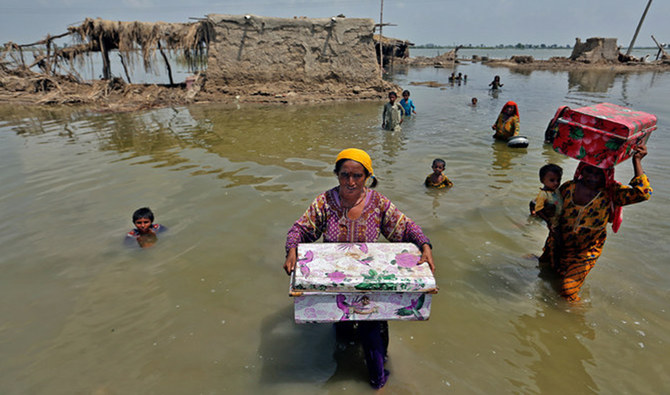DHAKA, Bangladesh: Protests in Bangladesh that toppled the government last year triggered a diplomatic pivot, with Dhaka warming toward China after neighboring India was angered by the ousting of its old ally Sheikh Hasina.
One year since the protests, that realignment risks intensifying polarization — and fears of external interference — as political parties in Bangladesh jostle for influence ahead of elections next year.
For the caretaker government, seeking domestic consensus for overhauling democratic institutions in the country of 170 million people, it is another challenge to juggle.
“India-Bangladesh relations have probably never experienced such intense strain before,” said New Delhi-based analyst Praveen Donthi, from the International Crisis Group.
There is deep resentment in Dhaka over the fate of fugitive ex-prime minister Hasina, who escaped a student-led uprising by helicopter in August 2024 and flew to New Delhi as thousands of protesters stormed her palace.
Interim leader Muhammad Yunus said popular anger in Muslim-majority Bangladesh had been “transferred over to India” because Hasina was offered sanctuary by New Delhi’s Hindu nationalist government.
Hasina, 77, has defied extradition orders to attend her crimes against humanity trial, and has already been convicted in absentia for contempt of court with a six-month sentence.
Md Touhid Hossain, who heads Bangladesh’s foreign ministry, said that “the relationship is now at the readjustment stage.”
Nobel Peace Prize winner Yunus’s first state visit was to China in March, a trip that saw him secure $2.1 billion in investments, loans and grants.
Beijing has also courted leading politicians directly.
Mirza Fakhrul Islam Alamgir, a senior leader of the Bangladesh Nationalist Party (BNP) — the expected election frontrunner — said China is “keen” to work with the next elected government with “sincerity, steadfastness, love, and affection.”
India has long been wary of China’s growing regional clout and the world’s two most populous countries compete for influence in South Asia, despite a recent diplomatic thaw.
Bangladesh has also moved closer to Pakistan, India’s arch-enemy.
In May, more than 70 people were killed in four days of missile, drone and artillery fire between the forces of New Delhi and Islamabad, sparked by a deadly militant attack on civilians in India-administered Kashmir.
The following month, officials from Dhaka and Islamabad met counterparts in China.
Chinese foreign ministry spokesperson Guo Jiakun said the trio had agreed to “cooperation programs” including in trade, industry, education and agriculture.
Obaidul Haque, who teaches international relations at the University of Dhaka, said talks with Beijing had “borne fruit,” including alternative health care after once popular medical tourism to India was restricted.
“For example, China designated three hospitals for Bangladeshi patients when India made access difficult,” he said.
Bangladesh and Pakistan — which split in 1971 after Dhaka’s independence war — began trade by sea last year, with direct flights also slated.
That sparked worry in New Delhi.
“The current Indian political leadership, owing to its ideological foundations... are unwilling to accept Dhaka under a government they perceive as Islamist and hostile toward India,” Donthi said.
“The visible engagement between Dhaka, Islamabad, and Beijing enhances this perception further.”
Both New Delhi and Bangladesh have imposed trade restrictions on each other.
India, which encircles much of Bangladesh by land, has imposed multiple trade restrictions — including tightening rules on Indian imports of jute fibers, ready-made garments, plastic products and food.
But trade between the neighboring nations remains high, said Md Humayun Kabir, a former Bangladeshi ambassador to Washington, who has also served in India.
But he urged caution, saying Dhaka should “tread carefully forming alliances,” and seek to strengthen “multilateral relations” as a balance.
“Cooperation still exists between the countries, but the warmth is gone,” he said.
Separately, Bangladesh, the world’s second-largest garment exporter, has also been caught in the global shakeup caused by US President Donald Trump’s tariffs.
Dhaka is proposing to buy Boeing planes and boost imports of US wheat, cotton and oil in a bid to reduce the trade deficit, with Yunus in June telling US Secretary of State Marco Rubio of his “commitment to strengthening” ties.
But in terms of regional tensions, analysts say little will change soon — and warn they have the potential to escalate.
“Things might change only if New Delhi is satisfied with the electoral process and sees somebody amenable to it come to power in Dhaka,” the Crisis Group’s Donthi added.
“It is very unlikely that their position will change toward the current government in Dhaka,” he said.
“There may be attempts to undermine it rather than to collaborate.”

















